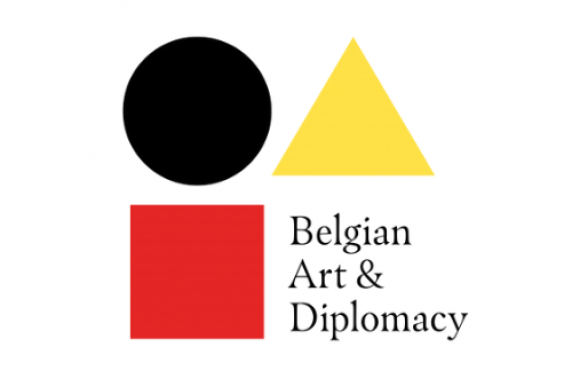-
Last updated on

Mission statement
The works of art in the public areas of the diplomatic missions and the Central Administration support a core task of the FPS, i.e. the representation of Belgium. They create an image of Belgium and encourage cultural dialogue. They contribute to a dynamic working atmosphere, sharpen the critical spirit and create opportunities for spiritual expansion. They offer a reflection on the ever-changing world. They help promote the values of Foreign Affairs, such as respect, communication, transparency, professionalism and sustainability. By offering a diverse, contemporary palette of artistic talent that extends beyond national borders and national identity, the art collection connects to the real world. Foreign Affairs wants to score well on the core tasks of collection management and a place in the global artistic landscape, as a reliable, professional partner with a sharp profile and its collection as a strong brand.
Positioning, collection profile and collaboration
The art collection of the FPS Foreign Affairs can be described as a semi-public corporate collection open to everyone. It is a collection that is part of the Belgian State. The collection belongs alongside the collections of other federal ministries and federal scientific institutions, collection managing institutions (Parliaments, Universities, Royal Palace, etc.), corporate collections (financial institutions), museums and art centers. The management of the collection is most comparable to that of the Ministries of Foreign Affairs of other countries. Here are a few examples:
Collection management
The management of the art collection focuses on four core tasks: inventory & documentation, collecting, conservation and restoration and finally presentation. Brussels, and more specifically the art heritage department, defines the policy.
Collection policy
The collection has been organically building up since the creation of the Belgian State in 1830. Since then, and especially after the Second World War, diplomatic missions abroad have been opened. Nowadays, some 240 buildings are scattered around the world.
The art heritage includes at least 4500 works, some 600 paintings, some 500 tapestries, some 3000 works on paper and some 200 sculptures, from the 16th century to the present day. More recently, other media have been added, such as photography, mixed media, installations and videos and in situ works. Almost all works of art are on permanent display. Sometimes they temporarily come to Brussels for restoration or for shipment to another destination. New acquisitions focus on contemporary art, mainly Belgian art as well as - after prospection - local artists. They work on a project basis. The external art purchasing and advisory committee, with external experts and internal members of the organisation, plays a role in both the prospection and validation phase. The final results are the "curated embassies and residences". To get an idea of the collection, the names of 100 contemporary artists whose work is included in the collection of the FPS Foreign Affairs follow:
Francis Alÿs - Nobuyoshi Araki - Carla Arocha-Abel Auer - Virginie Bailly - Sammy Baloji - Charlotte Beaudry - Charif Benhelima - Marcel Berlanger - Lieve Blancquaert - Guy Bleus - Delphine Boël - Sébastien Bonin - Mon Colonel & Spit - Berlinde De Bruyckere - Celine Butaye - Patrick Van Caeckenbergh - Sarah Carlier - Fia Cielen - David Claerbout - Sara Conti - Delphine Deguislage - Carl De Keyzer - Edith Dekyndt - Colin Delfosse - Ronny Delrue - Wim Delvoye - Alfred d’Ursel - Fred Eerdekens - Hadassah Emmerich - Thierry Falisse - Michel François - Lara Gasparotto - Kaif Ghaznavi -Tina Gillen - Shilpa Gupta - Mona Hatoum - Kati Heck - Ann Veronica Janssens - Viviane Joakim - Reina Saina Kallat - Nikita Kadan - Eddy Kamuanga Ilunga - Anish Kapoor -Marin Kasimir - Jean Katambayi Mukendi - Anne-Mie Van Kerckhoven - An-Sofie Kesteleyn - Aglaia Konrad - Sophie Kuijken - Marie-Jo Lafontaine - Sophie Langhor - Corinne Lecot - Elisabeth Lecourt - Namsa Leuba - Emilio Lopez Menchereo - Mark Luyten - Sarah Van Marcke - Cécile Massart - Michäel Matthys - Marcelo Moscheta - Aimé Mpane - Johan Muyle - Maryam Najd - Otobong Nkanga - Aimé Ntakayica - Sophie Nys - Hans Op de Beeck - Goedele Peeters - Max Pinckers - Marina Pinsky - Tinka Pittoors - Benoît Platéus - Marie-Françoise Plissart - Bernard Queeckers - Kelly Schacht - Georges Senga - Stefan Serneels - Helmut Stallaerts - Bart Stolle - Elly Strik - Walter Swennen - Johan Tahon - Pascale Marthine Tayou - Ana Torfs - Luc Tuymans - Sarah Vanagt - Koen van den Broek - Maarten vanden Eynde - Carole Vanderlinden - Catherina Van Eetvelde - Rinus Van De Velde - Yves Velter - Angel Vergara - Pieter Vermeersch - Katrien Vermeire - Ana Vester - Leen Voet - Jeff Wall - Sophie Whettnall
Exhibition policy
The Egmont Palace is still an unknown gem in the cultural heart of the Belgian capital, a stone's throw from the Royal Museums of Fine Arts, Bozar, the Royal Palace and the Little Sablon.
Since 2012, on the occasion of the Belgian National Day on 21 July, summer exhibitions have been organized in this palace. These exhibitions are freely accessible to the general public and have a very diverse range. Each time they attract around 5,000 visitors, in 2015 even up to 12,000, including heritage enthusiasts, art lovers, Brussels enthusiasts, tourists as well as casual, curious passers-by.
These exhibitions are realized by the internal art committee, the “kunstcomitéd’art”, and thanks to the help of various services and volunteers.

